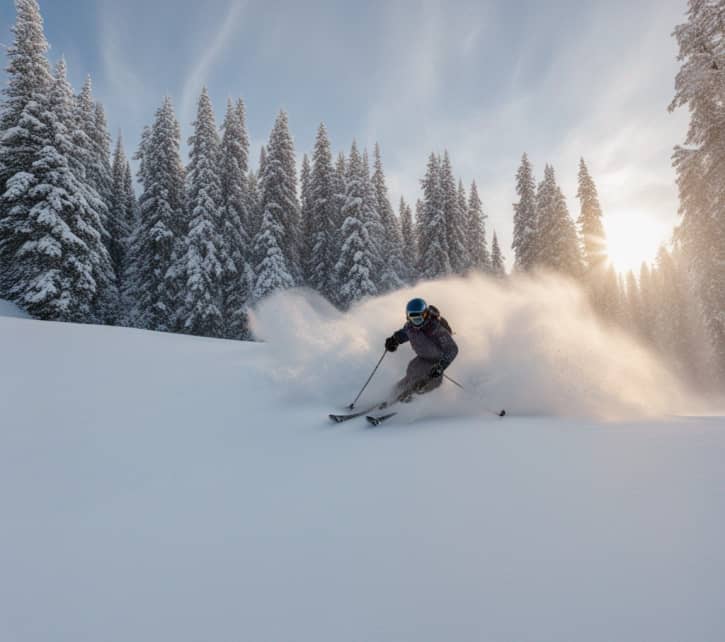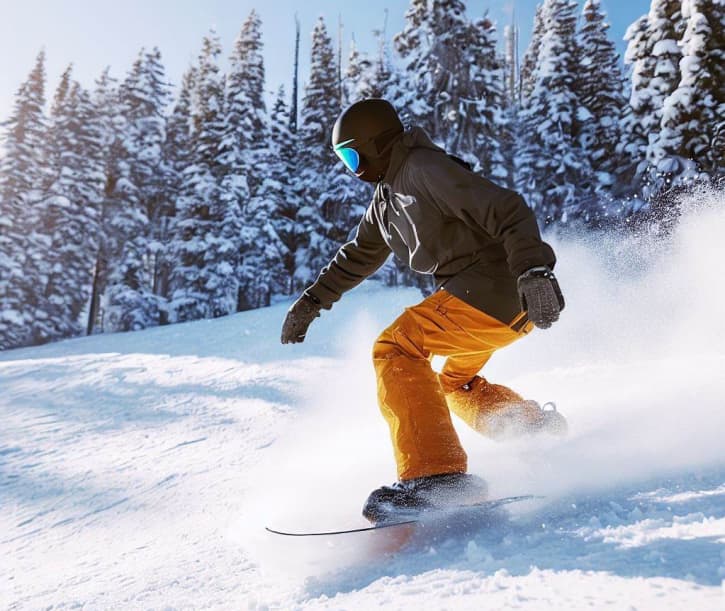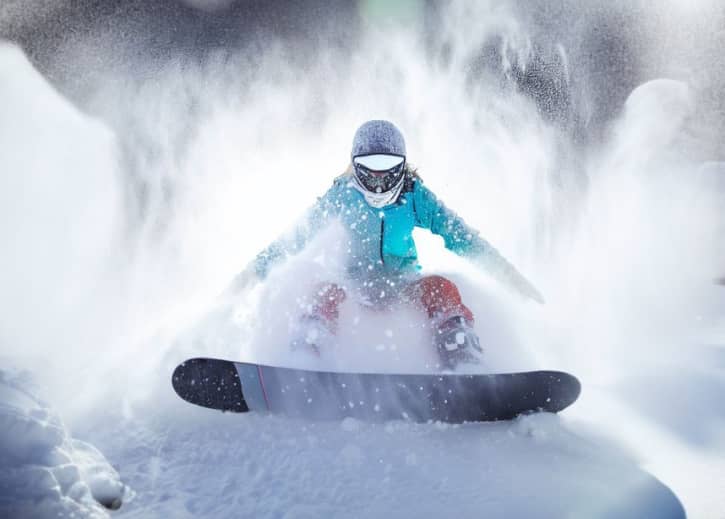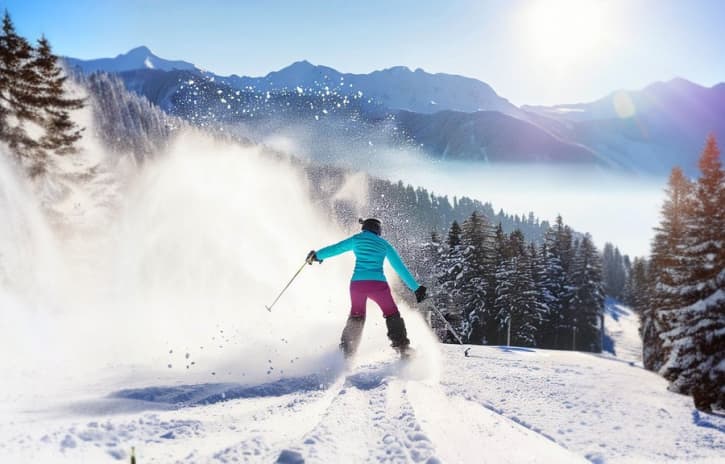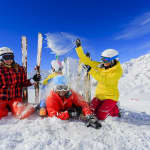Skiing is awesome! Among the most sought-after experiences for many skiers is the opportunity to ski powder. The allure of gliding on fluffy, untouched snow is irresistible to those who long for an exhilarating adventure on the slopes.
The joy of powder skiing keeps enthusiasts coming back to the slopes year after year, eager to experience the magic of this unique snow experience.
But here’s the thing – powder skiing isn’t as simple as regular skiing. It takes practice and has specific techniques of its own. Here are some tips to get you started.
Contents
What is Powder Skiing?
Powder skiing is what you get when you’re the first one on the trail after it snows. It’s gliding on fluffy, deep powder. Skiing on a cloud. Skiing on a sea of soft, powdery snow.
Freshly fallen snow is very light, dry, and fluffy. It’s the kind of snow that feels soft and airy underfoot. Like floating on clouds.
The unique characteristic of powder snow is that it has low water content and high air content, making it much lighter and less compact than other types of snow.
Skiing or snowboarding on powder is an exhilarating experience because the snow provides more cushioning and a smoother ride compared to other snow conditions. It allows skis or snowboards to glide effortlessly over the snow’s surface, giving a feeling of weightlessness and ease in turns. Skiing in powder snow is one of the most enjoyable and exciting experiences on the slopes.
When skiing on fresh powder, you keep yourself centered over your skis and maintain a narrow stance. To make turns, use your legs to rotate your skis. You’ll lose your balance if you rely on your edges. When you turn, you’ll create long, curved arcs. Don’t go as fast as you would on a groomed trail. Be safe and in control, or powder skiing can be dangerous.
Should I Use Specific Gear for Powder Skiing?
With powder skiing, using the right equipment can make a big difference. Look for skis with a width of 110 to 130mm underfoot, and they should have a rocker in the tail and the tip, with a softer structure. These features help you float on the snow and turn more smoothly. They also allow you to find a better balance by distributing your weight evenly between the skis.
Narrower skis are not the best choice for powder. They sink easier (though they are great for skiing on groomed slopes).
But buying a separate pair of skis just for powder might not be practical. It’s not easy to predict when you’ll encounter powder snow. In that case, invest in all-mountain skis that work well in different terrains, including powder. These skis usually have some rocker or early rise in the tip to help you float on top of soft snow. Their waist width is typically around 90 to 105mm, with wider tips and tails for a smoother skiing experience.
The Right Mindset for Powder Skiing
Before you ski powder for the first time, you need to get into the right mindset. Between turns, you will be pointing your skis downhill and gaining speed. Remember, if you happen to fall, don’t worry! The soft powder will cushion your landing.
It’s perfectly normal to make mistakes, so don’t get frustrated. Powder skiing can be challenging, and it takes time to master the necessary techniques. You will improve with practice, and soon you’ll be skiing in powder like a pro.
Techniques for Powder Skiing
1. Stay Centered: Maintain a slight squat position and focus on balance while distributing your weight evenly over both skis. Avoid leaning too far back or forward, as it can disrupt your balance on the powder.
2. Keep a Narrow Stance: Keep your skis at a hand’s length apart, ensuring they don’t touch each other. A well-spaced stance prevents loss of balance and potential crashes.
3. Distribute Your Weight: Unlike skiing on groomed slopes, distribute your weight equally on both skis when skiing in powder. Avoid applying excessive pressure to one ski, as it may cause it to sink and lead to a fall.
4. Create a Platform with Both Skis: Apply pressure on both skis simultaneously to create a stable platform, allowing you to float on top of the snow. Visualize skiing on one large ski instead of two separate ones to better distribute your weight.
5. Rotate with Your Thighs: When making turns, use your thighs rather than your knees and ankles to rotate. Maintain a narrow stance and rotate your thighs in your pelvis while leaning with your body. Avoid aggressive edging as you would on groomed slopes.
6. Bend and Extend: Employ a flexing and extending technique while turning. Bend and extend your legs during each turn to release pressure and move smoothly into the next turn. Maintain a strong core, ensuring your upper body and skis turn in sync.
7. Keep the Rhythm: Establish a flowing rhythm by timing your turns with wrist flicks and wide pole plants.
8. Make S Turns: Make long turns, similar to shaping an “S” on the snow surface. Perform slow and controlled rotations to manage your speed effectively.
9. Find the Right Speed: Balance your turning speed; avoid turning too fast or too slow. Too fast and you fall, too slow and you sink.
10. Face Downhill: Keep your ski tips pointed downhill and maintain parallel hips. Increase your downhill speed to maintain proper positioning and prevent abrupt rotations.
11. Look Forward: Keep your focus ahead instead of looking at your feet. Plan your turns and anticipate the next move to establish a smooth flow in your skiing.
Conclusion
In conclusion, powder skiing is a skill that takes time and practice to master. It’s not something learned overnight. It requires acquiring several techniques to gracefully float on the snow. However, if your dream is to ski powder, rest assured that every effort invested is worth it in the end. With discipline and determination, you can experience the joy of gliding effortlessly through the powdery slopes. So don’t be discouraged by the learning curve; keep pushing forward, and soon you’ll be relishing the magic of powder skiing with confidence and excitement. Happy skiing!

